Return to ITER Power Facts Main Page
Oct. 6, 2017 – By Steven B. Krivit
June 9, 2022 Note: Since 2017, we have developed more precise analyses of the projected ITER reactor power values than displayed in the graphs below. Please see the UTRC page and the Technical References page.
TL;DR FOR PLASMA PHYSICISTS
Members of your fusion science community promoted ITER with language that made it appear to laypersons as designed for Q-engineering=10, rather than Q-scientific=10. They did this for three decades. Nobody said a word.
Abstract
The International Thermonuclear Experimental Reactor (ITER) is the largest and most expensive science experiment on Earth today. Public outreach for the experimental fusion reactor, under the direction of Laban Coblentz, the head of the ITER communications office, has led journalists and the public to believe that, when completed, the reactor will produce 10 times more power than goes into it.
In fact, the reactor will lose more power than it produces from fusion. The planned output power of the reactor has been reported correctly, but the input power for the reactor has been widely reported, incorrectly, as 50 megawatts. The actual input power value, rarely discussed publicly, will be significantly larger.
For decades, some proponents of thermonuclear fusion research have used a double meaning for the phrase “fusion power” yet failed to inform the public, the news media, or legislators about the existence of this dual meaning. The secondary meaning of “fusion power” does not include the electricity required to operate the complex reactor and leaders in fusion organizations have not clearly disclosed this in their public communications. The resulting ambiguity has caused the public, the news media, and legislators to think that power produced by fusion experiments has been much greater than it really has been. It has caused them to think that technological progress in fusion has been much greater than it really has been. Specifically, it has caused them to think that ITER is designed to achieve a power gain six-to-ten times larger than its actual design specification. It has caused them to think that ITER is designed to produce net power when it really has not been designed, as a reactor, to produce any net power.
The false perception of the power gain of ITER follows a similar false public perception about its predecessor, the Joint European Torus (JET) reactor in the U.K. Some leaders in the fusion science community have used the secondary meaning of “fusion power” to convince the public that the record-setting 1997 fusion experiment in JET had produced thermal power at a rate of 65 percent of the electric power consumed by the reactor and, therefore, that the reactor had come close to producing as much power from fusion as the electrical power it consumed during operation. In fact, in that experiment, the reactor produced power in heat at a rate of less than 2 percent of the power in electricity it consumed. Coblentz and the ITER communications group have used the double meaning of “fusion power” to promote the publicly funded $22 billion ITER reactor, under construction now in southern France.

Click graph for larger image (Graph has been updated)
Fusion research insiders know that the current primary goal of ITER is not to demonstrate power amplification of the reactor. Instead, they know that the main goal is the power amplification of the fusion plasma; a significantly different measurement. Fusion experts say that non-experts understand the distinction, but virtually all evidence, as shown for example in news coverage by The New York Times, Scientific American, Bloomberg, Forbes and BBC News, is to the contrary. The double meaning of the phrase “fusion power” went unnoticed for years and has misled experienced journalists, scientists, members of the public and elected officials.
Full Text
(Full Text is Copyright 2017 ©New Energy Times, Duplication Prohibited)
(Average reading time: 25 minutes)
When I first learned that some thermonuclear fusion representatives had been promoting fusion results with a secondary meaning of the phrase “fusion power” — one that drastically changed the perceived importance of the data — I didn’t believe it. However, my sources were reliable and recognized experts. The first was Stephen O. Dean, one of the most well-recognized nuclear fusion proponents in the U.S. My second source was Michael Schaffer, a plasma fusion physicist who had worked for General Atomics. If what Dean and Schaffer told me was right, then the publicized power gain of the most powerful fusion reactor thus far — which purportedly produced heat output of 16 million Watts from a heat input of 24 million Watts — was inaccurate. It would mean that the device, the Joint European Torus (JET) fusion reactor at the Culham Centre for Fusion Energy in the U.K., didn’t come close to 65 percent efficiency, as has been widely claimed.
In fact, the real power efficiency of the JET reactor was, at best, 2 percent. If these fusion experts were right, the same type of confusion likely was also occurring with the promised claims of the $22 billion International Thermonuclear Experimental Reactor (ITER) now under construction in southern France.
 Slide #6 from Nick Holloway’s 2011 slide presentation
Slide #6 from Nick Holloway’s 2011 slide presentation
The actual rates of the power production of JET and the projected power production for ITER are nearly universally misunderstood by people who are not fusion experts.
The heart of fusion reactors such as JET and the forthcoming ITER reactor is a donut-shaped metal chamber called a tokamak, in which gaseous fuel is magnetically suspended and heated to form a plasma. The plasma is a hot, electrically charged mixture of deuterium and tritium gases, which, when heated to 150 million degrees Celsius, will react and undergo nuclear fusion. The fusion reactions emit fusion particles (helium and neutrons), which have kinetic energy that is converted into thermal energy.
 Interior photos of full-scale mockup of JET reactor. (Photos: S.B. Krivit)
Interior photos of full-scale mockup of JET reactor. (Photos: S.B. Krivit)
Among Journalists
Science journalists had thought that the publicized output efficiency (65 percent of the input power) of the JET reactor was based on a calculation that included all electrical power consumed by the JET reactor. For example, Charles Seife, an experienced science journalist and professor of journalism at Columbia University, wrote about JET in his 2008 book on nuclear fusion research, Sun in a Bottle.
“JET got 6 watts out for every 10 it put in,” Seife wrote. “It was a record, and a remarkable achievement, but a net loss of 40 percent of energy is not the hallmark of a great power plant.”
Journalist Lev Grossman wrote about JET in Time magazine on Oct. 22, 2015.
“The goal for all these machines is to pass the breakeven point,” Grossman wrote, “where the reactor puts out more energy than it takes to run it. The big tokamaks came close in the 1990s, but nobody has quite done it yet.”
Both Seife and Grossman (as I once did too) misunderstood the real power efficiency of JET. Each of their quotes above is fundamentally wrong.
A detailed explanation of these numbers is shown below. For now, the simple answer is that these numbers do not account for the electrical power required to operate the reactor. First, however, understanding the historical context is crucial.
When journalists have discussed fusion research, they have often used the words “power” and “energy” imprecisely. In a non-technical sentence, either term can generally be used. However, when discussing measurements, the terms are not interchangeable. Energy is the capacity to do work over a defined period of time and is measured in units such as kilowatt-hours. Power is the rate at which energy flows and is measured in units such as kilowatts.
Among Legislators
According to some fusion advocates, the JET reactor, with its 1997 record-setting result, had reached its design limitations. The fusion representatives convinced legislators that a newer, much bigger fusion reactor would be required to finally create net power from fusion. This enormous undertaking, they said, would require the collective scientific know-how from many nations along with contributions of materials and public funding. ITER was the way to fusion power, according to its promoters.
This is what fusion representatives told members of the U.S. Congress on May 5, 1993, during the U.S. House of Representatives Committee on Science, Space, and Technology hearing on fusion energy research. Anne Davies, the associate director for Fusion Energy Sciences in the Department of Energy, said that JET had produced 2 megawatts of fusion power. Davies failed to mention how much electricity JET had consumed. Paul-Henri Rebut, then the director of the U.S. ITER effort, testified that the ITER device “will be able to produce high-grade heat from controlled fusion reactions well over 1 billion watts.” Rebut failed to mention how much electricity ITER would require in order to operate.
Charles C. Baker, the U.S. ITER team leader and the associate director of the Fusion Energy Division at the Oak Ridge National Laboratory testified that “if ITER is built, which we all hope, it will essentially be a complete model of the core of an operating fusion reactor.” Baker’s written testimony said that “ITER will produce 1,500 to 3,000 megawatts of fusion thermal energy.” Baker failed to mention how much electricity ITER would require in order to operate.
Sixteen years later, on Oct. 29, 2009, the Subcommittee on Energy and Environment of the Committee on Science and Technology of the U.S. House of Representatives convened another hearing on fusion energy research. Stewart C. Prager, the director of the Princeton Plasma Physics Laboratory, testified that “ITER will produce 500 million watts.” Prager failed to mention that ITER was designed to consume at least 300 million Watts during steady-state operation. Edmund Synakowski, the associate director of the Office of Fusion Energy Sciences at the U.S. Department of Energy, testified that JET had produced “a few million watts of fusion power, enough to power thousands of homes.” Synakowski failed to mention that JET consumed hundreds of millions of Watts of electricity to get its 16 million Watts of fusion power.

Edmund Synakowski
JET’s Real Numbers
In 2014, while I was working on a book, one of my editors encouraged me to get better information on the progress in fusion research since the 1950s. Dean and Schaffer had already told me that the actual efficiency of the JET reactor wasn’t 65 percent and that the number was not based on the electricity consumed by the reactor. But what was the real-world power consumption? What was the real progress in reactor power over the years? Dean suggested that I contact JET directly. Nick Holloway, the media manager for the Communications Group of the Culham Centre for Fusion Energy, which operates the JET fusion reactor, responded promptly and clearly to my inquiry.
The electrical input power consumed by the JET reactor, Holloway told me, was at least 700 million Watts (megawatts, or MW) of electricity. Therefore, with a fusion heat output of 16 MW, JET came only within 2 percent (rather than 65 percent) of producing as much power as it consumed. The 2 percent number is based on a less-conservative of two calculation methods, comparing the fusion heat output rate to the electrical input rate. A more conservative calculation method normalizes the fusion heat power output to electrical power, using a 40 percent conversion efficiency, and gives a reactor power efficiency of less than 1 percent.
An Internet search for the electrical power consumed by JET returned no hits. As shown on the Internet Archive Web site, which preserves past versions of Web sites, the electrical input power for JET appeared for the first time, on the EUROfusion Web site, in 2015, after my enquiry to Holloway.
Dean and Schaffer explained to me why fusion scientists, among themselves, never talk about the electrical power requirements of fusion reactors: From their perspective, it’s irrelevant. That’s not fusion scientists’ current objective. A reactor that can produce power from fusion at a rate greater than the electricity it consumes has never existed.
I wanted to know whether Dean and Schaffer’s way of looking at the power rate from fusion reactors was common among fusion experts. In December 2014, I sent e-mails to each of the 20 members of the U.S. Department of Energy’s Fusion Energy Sciences Advisory Committee and asked them about fusion results. Six of them responded. It was true. Fusion researchers simply do not think about the electrical power that goes into the reactor. Instead, they think only about the heating power that is injected into the plasma.
Mark Koepke, professor of physics at West Virginia University, then the chair of the Department of Energy’s Fusion Energy Sciences Advisory Committee, and the immediate past chair of the Plasma Physics Division of the American Physical Society, was one of the respondents.

Mark Koepke
Koepke knew that JET had consumed 24 MW of injected thermal power to heat the plasma, but he told me that he didn’t know the electrical power consumed by the JET reactor. He wrote to me that power requirements in JET beyond those used for plasma heating were, in his words, “extraneous quantities.” Not one of the FESAC respondents knew the electrical power consumption of JET.
ITER’s Real Numbers
The next step was to look at the ITER claims. Claims on the ITER Web site said that the ITER reactor will “produce 500 MW of fusion power for 50 MW of input power (a power amplification of 10).” The ITER organization claims on its Web site that ITER “will take its place in history as the first fusion device to create net energy.” (Text on the ITER Web site is often imprecise in its use of the words energy and power. However, all stated values on the site are values of power.) If the 50 MW and 500 MW power numbers accurately represented what the reactor will do, ITER would not only produce net power but it would produce 10 times more power from fusion than it would require to operate.
There are two misleading parts of the 50 MW input power claim. The first part is that the publicized 50 MW input is not electrical power but instead, it is the power of the heat injected into the plasma. Even Michel Claessens, the former head of communications for ITER, did not know this.
Two fusion research professors who did not want to be quoted explained to me that the 50 MW of power, which enters the reactor chamber as radio frequency waves and energetic neutral beams, require the expenditure of at least 150 MW of electricity.

Michel Claessens
The second misleading part is that the electrical input power for the entire reactor goes toward many other power-consuming systems than just the plasma heating systems.
When the power gain is calculated using the full required electrical power, and using a less-conservative calculation method (heat output versus electrical input), ITER will produce thermal power at a rate of 1.6 times rather than 10 times the electrical power it will consume. (See graph below.) Using a more-conservative calculation method (heat output normalized to electricity), ITER will have a (negative) gain of 0.71 rather than a (positive) gain of 10. (See graph above.)
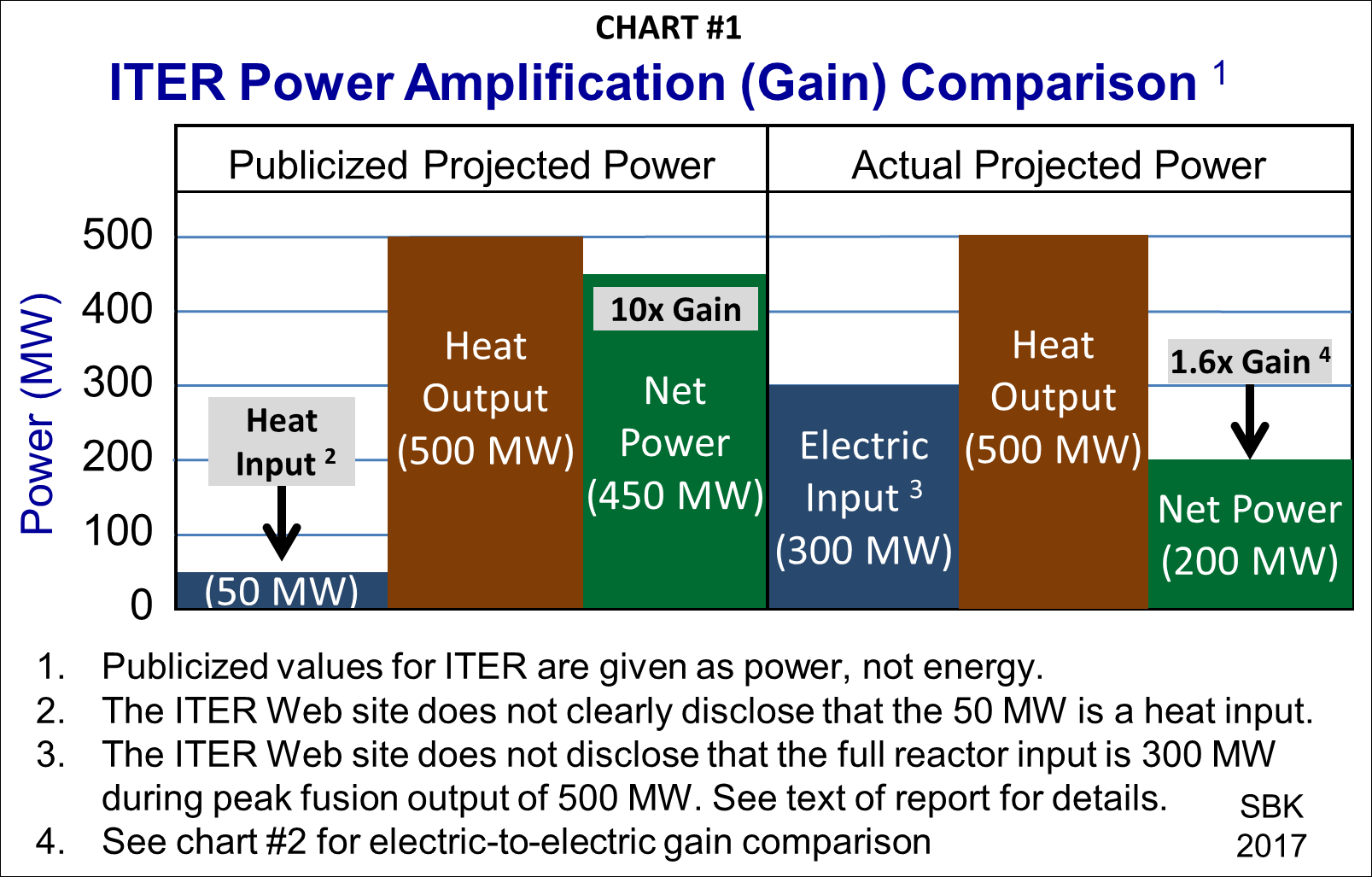
Nearly all recent news reports about the ITER reactor say that it will produce power at a rate 10 times greater than it consumes. Making sense of this massive misunderstanding requires a brief review of some of the history, some scientific terminology, and analysis of the public communication about ITER.
Fusion Power
Here is an example of what experts have told non-experts about the results of fusion progress. Stewart C. Prager, the director of the Princeton Plasma Physics Laboratory, testified before members of Congress during the Oct. 29, 2009, hearing.

Stewart C. Prager
“By any metric, we are far along the road to commercial fusion power,” Prager said. “In the past 30 years, we have progressed from producing 1 watt of fusion power for one-thousandth of a second to 15 million watts for seconds, and ITER will produce 500 million watts for 10 minutes and longer. … The most recent National Academy [of Sciences] study notes remarkable progress in recent years. But my focus today is the future, the remainder of the journey to fusion power.”
Prager’s statement included two meanings for the phrase “fusion power.” Fusion experts will recognize the different meanings from their knowledge of fusion science and the context of Prager’s statements. The public is likely to have no idea that Prager’s first and third uses of the phrase “fusion power” meant anything different from his second use of the phrase “fusion power.”
Prager, and everyone else who testified before Congress that day, failed to explain that, when they used the phrase “fusion power” in the context of “millions of Watts of fusion power,” they were using a secondary, technical meaning. They didn’t tell Congress that the secondary meaning for the phrase “fusion power” existed.
Many decades ago, fusion scientists began using the phrase “fusion power” to identify the power, in heat, produced by fusion reactions. In this context, “fusion power” excludes the electrical input power required by a fusion reactor.
For example, the EUROfusion organization, a consortium that manages and funds European fusion research, wrote on its Web site that JET “is the only operational fusion experiment capable of producing fusion energy.” That Web page gives readers no indication that JET, at best, produced 16 MW of power from fusion at a cost of 700 MW of electricity from the grid.
Obscured ITER Input Power
The ITER Web site does not give a discrete value for the reactor electrical input power requirement. Instead, it commingles power consumption rates for non-reactor site requirements with reactor power requirements. For example, it says that “the ITER plant and facilities will range from 110 MW to up to 620 MW …”
In December 2016, I asked Laban Coblentz, the communication head of ITER, for a precise value for the reactor electrical input power requirements. He gave a lengthy response but failed to answer the only question I had asked. I asked Coblentz the question three times, and three times Coblentz failed to provide the answer. On the other hand, I asked for the same information from three independent fusion experts. I asked each of them only once. Each of them, within a few days, responded only once, with a clear and direct answer. All responses were consistent with one another. Coblentz had the entire ITER staff at his disposal and yet he was unable to provide me with this basic fact.
Several U.S. fusion experts were also not forthcoming when I asked them for the ITER reactor electrical input power requirements. Twice, I asked Don Rej, the chair of the U.S. Fusion Energy Sciences Advisory Committee, whether he could tell me the electrical input power required to operate ITER during its peak 500 MW output. At the time, Rej shared the leadership of that committee with Synakowski. Rej deflected my question both times and, without explanation, said that I should ask Coblentz. I asked Mark Uhran, the U.S. ITER communications manager, and Ned Sauthoff, the U.S. ITER project director. I also asked Ernest Moniz, the former U.S. Secretary of Energy. Not one of them responded.

Laban Coblentz
However, three other sources (see below) were able to quickly, clearly, and succinctly give me the answer to this question.
A document by Ivone Benfatto, the head of the ITER Electrical Engineering Division, shows that ITER is designed to consume far more than 50 MW of electrical power. Benfatto’s document, “Power Converters for ITER,” shows that ITER will draw hundreds of megawatts of power from a dozen hydroelectric and nuclear power plants in the nearby Rhône Valley.
I also had located a U.S. Department of Energy document that explained that the ITER reactor will use two sets of power supplies. One is the Pulsed Power Distribution System, designed to deliver up to 500 MW of power for short intervals. The other is the Steady-State Electric Power Network, which will deliver up to 120 MW of continuous power.
Key Source
But the ITER reactor will consume different amounts of electrical power during different phases of operation. On April 19, 2017, the Bulletin of Atomic Scientists published an article by Daniel Jassby, a former principal research physicist at the Princeton Plasma Physics Laboratory. His article was titled “Fusion Reactors: Not What They’re Cracked Up to Be” and he spoke with me.

Daniel Jassby
Jassby explained that ITER will have three primary sets of power-consuming systems. The first will be the steady-state power, drawing about 100 MW of electricity. This occurs always, during the startup phase, the fusion phase, and even when the reactor is not operating. The power is necessary for a variety of essential reactor systems such as liquid-helium refrigerators, water pumps, vacuum pumps, temperature controls for the reactor buildings and tritium processing systems.
“The second set of power-consuming systems will consume about 300 MW of electricity for about 20 seconds,” Jassby said. “This will be required before the start of the fusion phase. It will be used primarily for the various magnetic and electrical systems to start up the discharge and reach operating conditions. This 300 MW of electricity will not be used during the fusion phase. The total power consumption before the fusion phase will therefore be about 400 MW of electricity.”
“Third,” Jassby said, “during the fusion phase, the electric power consumption for the reactor’s plasma heating systems, current drive, and magnetic controls will be about 200 MW of electricity. The total power consumption during the fusion phase therefore will be about 300 MW of electricity.”
Hidden Input Power
The image below, from the ITER Web site, provides a further example of how the ITER organization, in its definition of “net energy,” has hidden the required electrical input power for the reactor and the actual reactor power gain. The ITER Web site editors’ sloppy use of the words power and energy is a side issue: The ITER numbers are always publicized in terms of power (megawatts) rather than energy (megawatt-hours).
 ITER Web site definition of net energy (Image retrieved Aug. 19, 2017)
ITER Web site definition of net energy (Image retrieved Aug. 19, 2017)
A more accurate statement would include all the machine’s required power systems, not just the heating system. Coblentz has argued with me that they are not obligated to disclose the required electrical input power for the reactor because the objective of the reactor is not intended to produce net power or net energy. Yet the claim above clearly states that “ITER will be the first fusion device to produce net energy.” In common parlance, this is called “bait and switch.”
Confirmation
If Jassby was right, then ITER’s publicized 50 MW of input power was wrong. Twice, I sent Jassby’s summary of the ITER power requirements to David Campbell, ITER’s chief scientist, and asked for concurrence or corrections. Campbell did not respond. However, two other independent fusion experts promptly and clearly answered the question “How much total electrical input power (not just the 50 MW plasma heating power) will be required for all systems on ITER, during its peak fusion power production of 500 MW thermal?”
One expert was Hartmut Zohm, the head of the Tokamak Scenario Development Division at the Max-Planck-Institute of Plasma Physics.

Hartmut Zohm
“From my discussions with some of the ITER team members,” Zohm wrote, “I learned the following: At the peak operation point, ITER will produce 500 MW of fusion power which is 10 times the external power needed to heat the plasma.
The magnet system will require about 80 MW of electrical power and the heating systems about 150 MW. Add to this an overall consumption of the site of around 100 MW (for all subsystems needed to run the whole plant), we would have about 330 MW of electrical power needed to run the machine in this state.”
The other expert to confirm the ITER power requirements was Steven Cowley, chief executive officer of the United Kingdom Atomic Energy Authority. He wrote that, in ITER, for a 50 MW thermal input, “with the efficiency of the beams etc., the electrical power in would be over 300 MW.” Cowley concurred that the primary goal of ITER is a 500 MW thermal output for a 50 MW thermal input, but he also said that, according to computer simulations, the reactor might get hot enough for ignition, where no external heating would be required. This is contradicted by an article in Nature, in which Cowley is quoted as a source, that says that ITER is not designed for ignition.

Steven Cowley (Photo: Royal Society)
Based on the information published on the ITER Web site power-supply page, in the Benfatto document, in the DOE document, and from the three expert sources, the claimed 50 MW input for ITER — as understood by the public — is a fiction. Therefore, the claim of a 10-fold gain in power is also a fiction. The claim that the ITER reactor will produce more power from fusion than it consumes in electricity is a fiction.
ITER Output Power
The ITER reactor is designed to and expected to produce fusion-produced particles that will be emitted from the fusion plasma. Most of the energy produced by the fusion reaction will be carried away from the plasma by the fusion-produced neutrons. These neutrons will be absorbed by the walls of the reactor, where their kinetic energy will be converted to 400 megawatts of heat. 100 MW of heat produced by the fusion reactions will remain inside the reactor. ITER is not designed to use this heat to produce any usable power, let alone electricity. Instead, the heat will be captured by cooling water and dispersed to the atmosphere through cooling towers.
ITER Power Gain
Therefore, if the total heat output is 500 MW and the minimum total reactor electrical input is 300 MW, the reactor will demonstrate a power gain, or amplification, of 1.6 times, not 10 times. An amplification of 1.6 is the best-case scenario because more-critical observers will argue that only like terms can be compared. They will argue that heat power and electrical power cannot be directly compared. Therefore, if the heat output is normalized to electricity, with a conversion efficiency of 40 percent, the reactor will actually produce less electric-equivalent power than the electricity it consumes, resulting in an efficiency of 0.66 and a net loss of 100 MW. If exothermic neutron absorption is taken into account, the 0.66 efficiency goes up to 0.71.
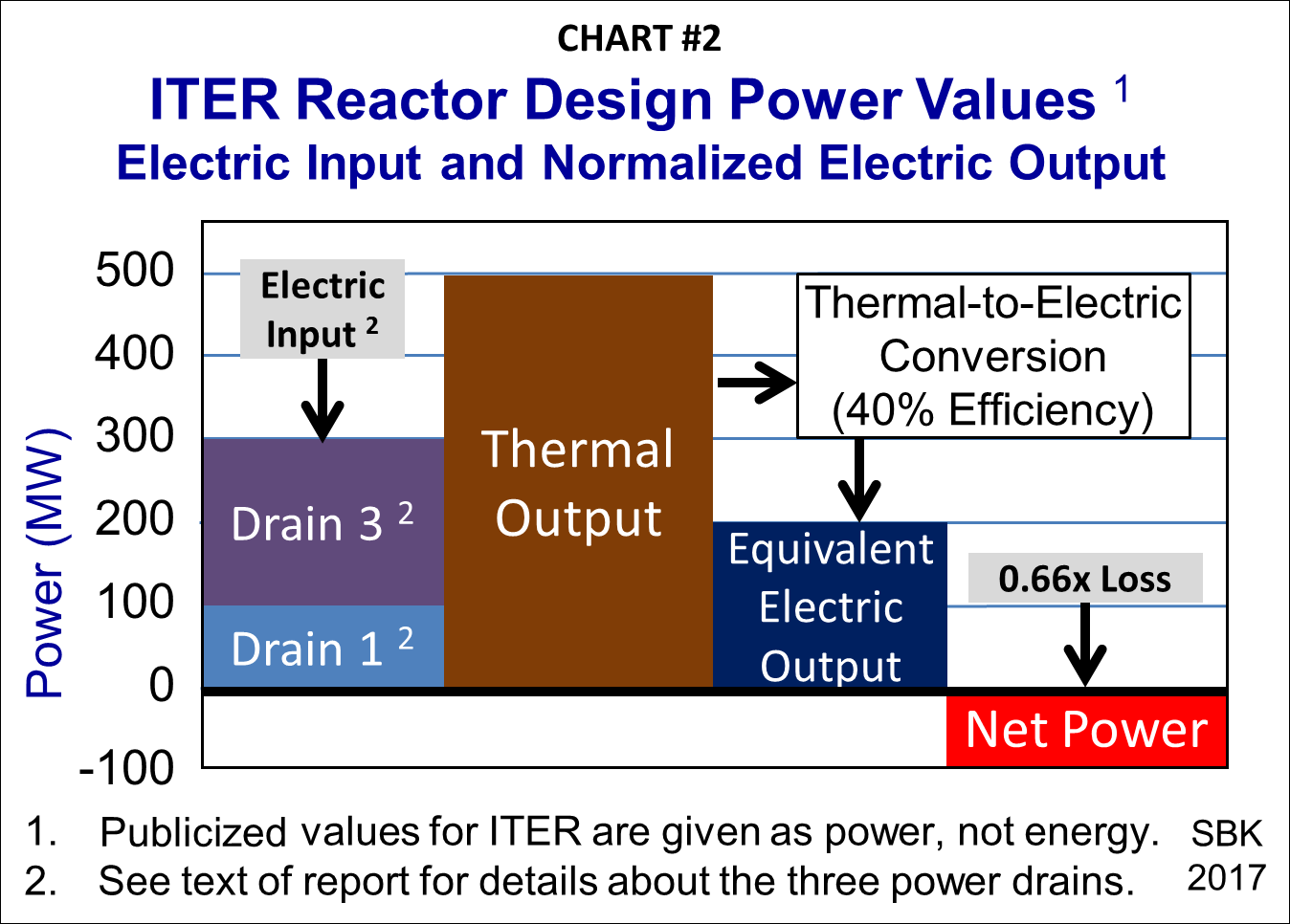
Fusion scientists are concerned with only the plasma power gain. The public is interested primarily in reactor power gain. Here is a summary of the three ways to look at the projected power gain of ITER.
Misleading the Journalists
Most journalists who have written about JET or ITER, including me, have unknowingly taken communications by fusion representatives at face value and published incorrect or misleading statements about the reactors. Here are a few samples:
- Steven Krivit, Pacific Oaks Press, June 2004: [JET] “has generated, at its best, only 60 percent of the input power it consumed.”
- Geoff Brumfiel, Scientific American, June 2012: “It will generate around 500 megawatts of power, 10 times the energy needed to run it.”
- Raffi Khatchadourian, New Yorker, March 3, 2014: “[ITER will] produce ten times the energy fired into the plasma, at half a gigawatt.”
- Ethan Siegel, Forbes, Aug. 27, 2015: “The breakeven energy point in nuclear fusion [is] where we get out as much energy as we put in. … The reality is we’ve moved ever closer to the breakeven point.”
- Daniel Clery, Science, Nov. 19, 2015: “The ITER project aims to show that nuclear fusion — the power source of the sun and stars — is technically feasible as a source of energy. Despite more than 60 years of work, researchers have failed to achieve a fusion reaction that produces more energy than it consumes. ITER … is the biggest attempt so far and is predicted to produce at least 500 megawatts of power from a 50 megawatt input.”
- Nathaniel Scharping, Discover, March 23, 2016: “ITER is projected to produce 500 MW of power with an input of 50 MW … enough energy to power roughly 50,000 households.”
- Davide Castelvecchi and Jeff Tollefson, Nature, May 26, 2016: “[ITER] is predicted to produce about 500 megawatts of electricity.”
- Dave Loschiavo, Ars Technica, July 3, 2016: “[ITER] is projected to produce 500MW of fusion energy while consuming 50MW to heat the hydrogen.”
- Damian Carrington, The Guardian, Oct. 17, 2016: “ITER should be completed in 15-20 years and aims to deliver 500MW of power, about the same as today’s large fission reactors.”
- Damian Carrington, The Guardian, Dec. 2, 2016: “‘We are convinced we can deliver hundreds of megawatts through ITER,’ up to 10 times more energy than is put in, says David Campbell.”
- Henry Fountain, New York Times, March 27, 2017: “ITER will benefit from its larger size and will produce about 10 times more power than it consumes.”
- Fraser Cain, Universe Today Web site, May 28, 2017: “If all goes well, ITER will have a ratio of 10. In other words, for every 10 MW of energy pumped in, it’ll generate 100 MW of usable power.”
- Jing Cao, Bloomberg, June 29, 2017: “[ITER’s] developers say it’ll produce 500 megawatts of power using 50 megawatts to get the reaction going.”
- Edwin Cartlidge, Nature, July 6, 2017: “ITER [will] generate electricity only in bursts of a few minutes.”
- Edwin Cartlidge, BBC News, July 11, 2017: “[ITER] is designed to generate 10 times the power that it consumes.”
- Jason Socrates Bardi, Inside Science, July 17, 2017: “The goal of ITER is to prove it’s possible to produce a net gain of energy. That means it will produce more power than it takes to make it. It will produce 500 megawatts of output power but only use 50 megawatts of input power.”
Every statement above, with the exception of Khatchadourian’s and Loschiavo’s, is incorrect. Khatchadourian’s and Loschiavo’s statements, while factually correct, are misleading because they did not tell their readers that the 500 MW output will require much more power than that used to heat the fuel.
The ITER power misunderstanding is so ubiquitous that an error of this breadth and magnitude seems inconceivable. Nevertheless, this is what has happened.
No Electrical Output
Here is how Nature, one of the world’s most authoritative science news sources, reacted when I told its reporters that ITER was not designed to produce electricity. In 2016, Davide Castelvecchi and Jeff Tollefson wrote that ITER would “produce about 500 megawatts of electricity.” In 2017, Edwin Cartlidge, made the same mistake in Nature. I submitted a comment on Nature’s Web site with corrections to Cartlidge’s article, and it appeared on the site immediately.
Four days later, Nature corrected the article. Rather than acknowledging my assistance, Nature removed my entire comment without explanation and locked the article from further comments. This is the second such deletion by Nature of one of my posted comments on ITER. The first was in response to Elizabeth Gibney’s Jan. 27, 2107, article on ITER. As of Sept. 28, 2017, the Castelvecchi-Tollefson error is still on the Nature Web site.
Some fusion representatives have claimed that ITER will produce as much power as a small fission reactor despite the fact that the reactor is not designed to produce any net power. In the real world, one of the smallest nuclear fission power plants is the R.E. Ginna site in Ontario, New York. It has an electrical output capacity of 576 MW. Its thermal output is 1,700 MW. I spoke with Maria Hudson, a communications manager for Exelon Generation, the site operator. She said the electrical input power required to operate the entire reactor is only 22 MW.
Not Self-Sustaining
In 2016, Jonathan Menard, a program director at the Princeton Plasma Physics Lab, told Business Insider that ITER “will be almost completely self-sustaining.” He did not inform Business Insider about the 300 MW of electricity that ITER is designed to consume during steady-state operation. A 2003 press release from the White House, based on information it received from experts, said that the goal of ITER is to generate a self-sustained fusion reaction. That press release also omitted the electrical input power.
By its own design, ITER will take a 300 MW flow of electricity, a high-grade form of power, and turn it into a 500 MW flow of heat and warm the planet.
ITER will also not be the first fusion reactor to accomplish sustained controlled fusion. In 1997, JET sustained a fusion plasma for six seconds. In 2017, China’s Experimental Advanced Superconducting Tokamak (EAST) maintained a stable plasma for 101.2 seconds.
In my conversations with fusion experts, I found that they often use the ambiguous term “self-heating” to differentiate internal plasma heating (helium) from external plasma heating (NBI and RF.) I pointed out to Cowley that members of the public could easily misinterpret “self-heating” to mean “self-sustaining.”
“You are correct. We use [self-]heating to mean the plasma heating, so really I should say self-plasma heating,” Cowley wrote. “Yes, this comes from the helium nuclei, also called alpha particles, which stay in the plasma.”
Cowley also defined “ignition” as the condition in which a fusion plasma is sustained without any external plasma heating; that is, the plasma is sustained only by the generated helium nuclei.
Some fusion experts use the phrase “burning plasma” to describe the expected results of ITER and other fusion reactor systems. But “burning plasma” does not mean “self-sustained” plasma, as members of the public mistakenly believe.
In fact, within the fusion community, there is no agreement as to the meaning of the phrase “burning plasma.” The U.S. National Academy of Sciences defines a burning plasma as a plasma “in which at least 50% of the energy to drive the fusion reaction is generated internally.” The Max Planck Institute in Germany defines a burning plasma as a plasma in which “so many fusion processes occur that the energy of the helium nuclei produced is almost or completely sufficient to maintain the temperature of the plasma.” Therefore, “burning plasma” means whatever the person using the phrase wants it to mean.
Not Commercially Viable
CNN reporter Thom Patterson published a news story on fusion in 2015. One of Patterson’s sources was Coblentz. Patterson wrote that, “to be commercially viable,
have to create more energy than the original energy you use to heat the fuel.”
As has happened with so many journalists, Patterson’s sources omitted to inform him of the electrical input power required to operate the reactor.
Not Sold as a Science Experiment
After I questioned Coblentz about the projected electrical input power required to operate the reactor, he denied that reactor power gain was the main goal of ITER. Instead, said that the fusion plasma gain was the main goal. He was right, of course, but that’s not how he and his colleagues have promoted ITER to the public, the news media, or elected officials.
 Publicized goal of ITER, as shown on ITER project “Facts and Figures” Web page (Image retrieved Sept. 30, 2017)
Publicized goal of ITER, as shown on ITER project “Facts and Figures” Web page (Image retrieved Sept. 30, 2017)
Some ITER representatives have said that other benefits will come from ITER, such as increased understanding in a number of fusion-related engineering areas that will aid in scientific advancement. While true, this, too, is not how ITER was and continues to be sold. ITER has been sold to the public as “an energy source that is inexhaustible,” as this promotional document dated sometime before 2000 from General Atomics, an ITER contractor, shows.
Here is a screenshot from the ITER organization’s home page that says, “Harnessing fusion’s power is the goal of ITER.” Another page on the ITER Web site says, “The main goal of ITER and future fusion reactor-based power plants is to develop a new, sustainable and virtually unlimited energy source.”
The ITER Web site and literature promote ITER’s promised forthcoming achievements without clarifying, let alone defining, the double meaning of “fusion power.”
Although fusion experts see such claims and understand which meaning of “fusion power” applies to the ITER organization’s primary claim, non-experts do not. As a result of this misunderstanding, non-experts expect that the power gain of ITER will be six-to-ten times higher than it actually will be.
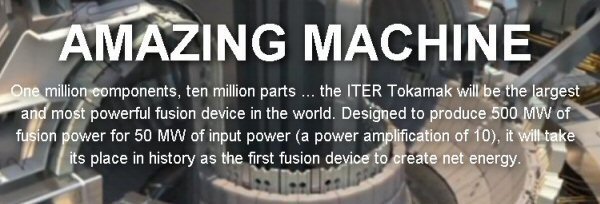 Image from ITER Web site home page (May 10, 2017)
Image from ITER Web site home page (May 10, 2017)
Concurrence
After I published my Jan. 12, 2017, report “The Selling of ITER,” Claessens published a response on his Twitter account and encouraged his peers to use clearer language.
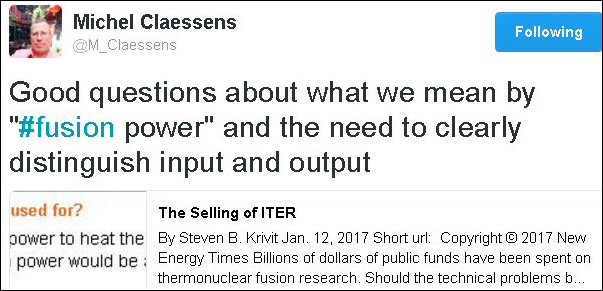
Claessens then wrote to me providing further concurrence with my report. He was eager to set the record straight and help correct the public communication about the ITER project. He provided further agreement with my facts and analysis during my interview with him. Claessens was responsive to all my questions.
Ad Hominem
Coblentz, however, took a different approach. He sent an e-mail to 18 journalists and, without identifying any factual errors or omissions in my report, transmitted false statements about me to them.
Coblentz reports to Bernard Bigot, the ITER director. Bigot reports to the ITER Council, which comprises non-permanent representatives from each of the member nations and the European Union.
The ITER Council is ultimately responsible for the promotion and overall direction of the ITER organization. The council meets twice a year and its chairman is Won Namkung. Its next meeting is in November. Here is a list of the names and photos of the representatives who attended the June 2017 meeting. Because new members change every two years, the council has no long-term accountability to members of the public in their nations whom they represent.
The Fusion Game
ITER representatives are not alone in making unsubstantiated or misleading fusion claims. The Web site for the Culham Centre for Fusion Energy, home of the JET reactor, in its FAQ section, asks the question, “What is the power input to the fusion reactor used for?” It provides this answer: “The best existing experiments need as much power to heat the plasma as they produce in fusion power.”
That answer is valid only if you omit the required electrical input power for JET. The correct answer to that question, as phrased, is that the best experiment required 43 times more input power (700 MW) for the fusion reactor than it produced in fusion power (16 MW).
In October 2014, Lockheed Martin created widespread publicity with its claim that it would be delivering a working prototype of a fusion reactor within five years. However, the company provided no public data, no published paper and no prototype to support its public relations campaign. I asked its public relations staff for answers to the most basic questions about input and output. They had no data to share.
On June 15, 2017, the Massachusetts Institute of Technology published an article on its energy Web site announcing a reactor design called ARC. According to the June 15 article, ARC is a reactor concept based on an incomplete engineering design that had been developed by a class of MIT students. The following day, on June 16, MIT published a similar article (click here for a comparison) on its news Web site announcing a fusion device called SPARC.
The article quoted professor Dennis G. Whyte, the director of the MIT Plasma Science and Fusion Center, and nuclear engineering professor Anne White, who said that SPARC “will carry out the world’s first demonstration of net energy from a fusion experiment — making SPARC the first fusion device to make more power than it consumes.” I sent an e-mail to Whyte on June 16 asking for basic data about projected input and output power. He responded the next day.
“Thanks for your interest, but the requested information is reserved for our private-sector sponsors,” Whyte wrote.
When I later noticed that the June 16 article was missing from the MIT news site, I contacted Emily Dahl, the communications director for the MIT Energy Initiative. She confirmed to me that the June 16 article had been a mistake and had been removed on June 17.
From Fusion Fraud to Physics Fortune
The ITER project, supported by a widespread misunderstanding of its promised results, funded by billions in public money, resources and materials, is not designed to deliver a practical demonstration of fusion power, but merely a scientific demonstration of a sustained fusion reaction. Yet on July 3, 2017, the Chinese Experimental Advanced Superconducting Tokamak reactor already did this, for 101 seconds. When built, ITER will merely do it for four times longer.
Coincidentally, the quest for practical nuclear fusion on Earth was born out of fraud. The ITER Web site, perhaps ironically, recognizes this, with a page titled “Proyecto Huemul: From Fusion Fraud to Physics Fortune.”
The story began in 1948 in Argentina when Austrian scientist Ronald Richter proposed his idea for a fusion device to President Juan Perón. Perón agreed to fund the concept, and on March 24, 1951, Perón held a press conference at which he announced that his country had achieved practical, controlled nuclear fusion. By 1952, however, after independent investigators reported no evidence to support the claims, the project was shut down. The ITER page calls it “the scientific fraud of the century.”
Yet in 1951, before the Argentinian project was shut down, the project caught the attention of Lyman Spitzer, an astrophysicist at Princeton University. Spitzer, in turn, approached the U.S. Atomic Energy Commission and convinced it to fund his own fusion research concept. Thus, the U.S. controlled nuclear fusion era began at the Princeton Plasma Physics Laboratory, and the worldwide race for fusion energy began.
Since construction on ITER began in 2007, nuclear fusion news stories have been tagged with titillating headlines about unlimited energy. A CNN story headline is typical: “Is Nuclear Fusion About to Change Our World?”
Every incremental step forward in higher temperature, greater pressure, or longer plasma confinement time has been a “breakthrough.” Each breakthrough, according to the news stories, has seemed to bring the dream of fusion on Earth one step closer. Rarely have the stories featured any critical assessment or analysis.
One journalist wrote that physicists at the Department of Energy’s Princeton Plasma Physics Laboratory had “demonstrated” how a new fusion reactor design could lead to the first commercially viable nuclear fusion power plant. The demonstration was merely on paper. The article featured a photo of a reactor. But it wasn’t the reactor described in the article. That reactor hadn’t been built yet.
As the comics below show, the very same Princeton Plasma Physics Laboratory — back in 1975 when the DOE was called the Atomic Energy Commission — told journalists it was a big step closer to virtually limitless pollution-free energy thanks to “breakthroughs” in plasma density and temperature.
Then there’s MIT scientist Earl Marmar, who told journalists this year that the technology exists to have fusion energy in 13 years if only it is funded aggressively enough.
Vision and hope are wonderful and necessary components of scientific progress. But false hope and empty promises — laced with misleading claims — serve no one but the recipients of publicly funded science. Fusion reactors that produce zero net power do not help a world grappling for solutions to climate change.
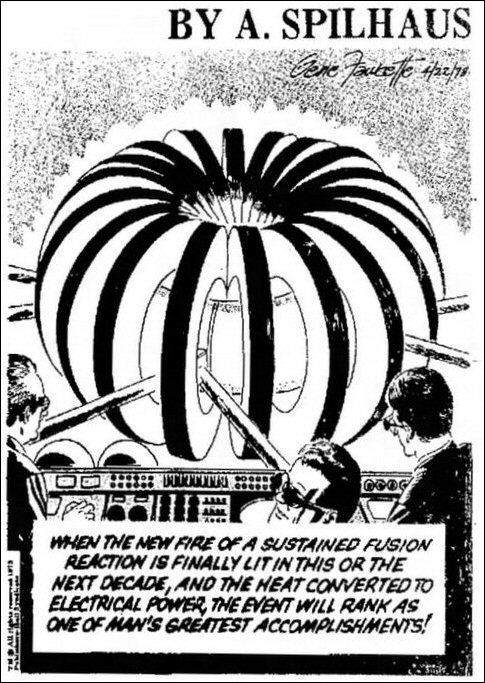
Our New Age comic strip, April 22, 1975
———————
Steven B. Krivit began his science journalism career focusing on low-energy nuclear reactions (LENR) in 2000. He initially reported on the work of credentialed scientists who claimed that they had experimental evidence of “cold fusion.” However, by 2008, Krivit had identified eight experimental facts that disproved their “cold fusion” hypothesis. Since then, Krivit has published extensively, in encyclopedias and peer-reviewed journals, about the distinction between the erroneous idea of “cold fusion” and the valid science of LENRs. His distinction was adopted by the Library of Congress in 2016 for its authoritative subject heading index. Krivit’s latest article on LENR was published by Scientific American on Dec. 7, 2016.

 False and misleading 2008 statement by Neil Calder, former head of ITER public communications (Source)
False and misleading 2008 statement by Neil Calder, former head of ITER public communications (Source)



 Slide #6 from Nick Holloway’s 2011
Slide #6 from Nick Holloway’s 2011  Interior photos of full-scale mockup of JET reactor. (Photos: S.B. Krivit)
Interior photos of full-scale mockup of JET reactor. (Photos: S.B. Krivit) 











 Image from ITER Web site home page (May 10, 2017)
Image from ITER Web site home page (May 10, 2017) 

